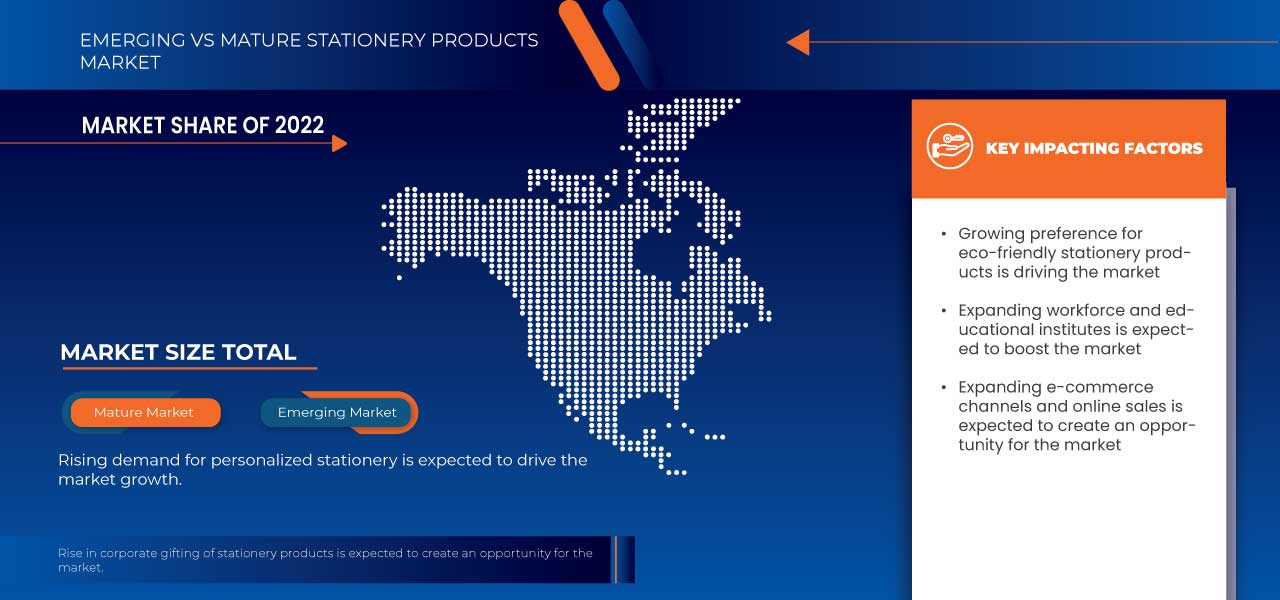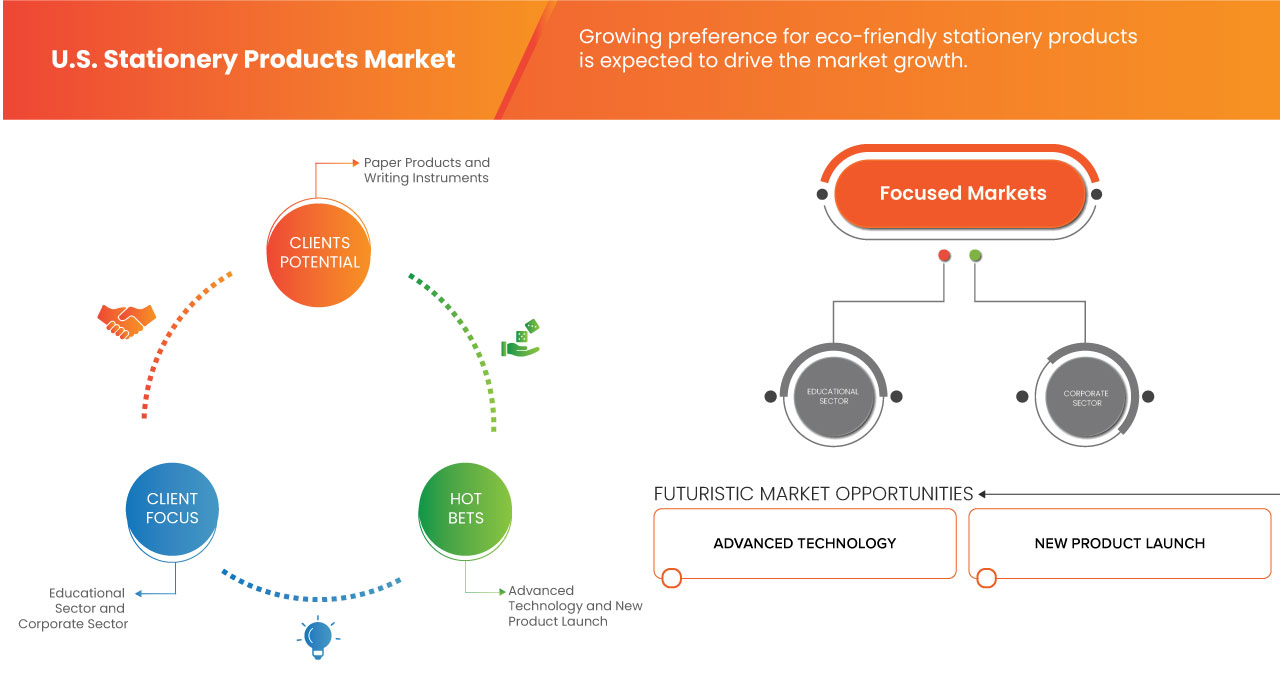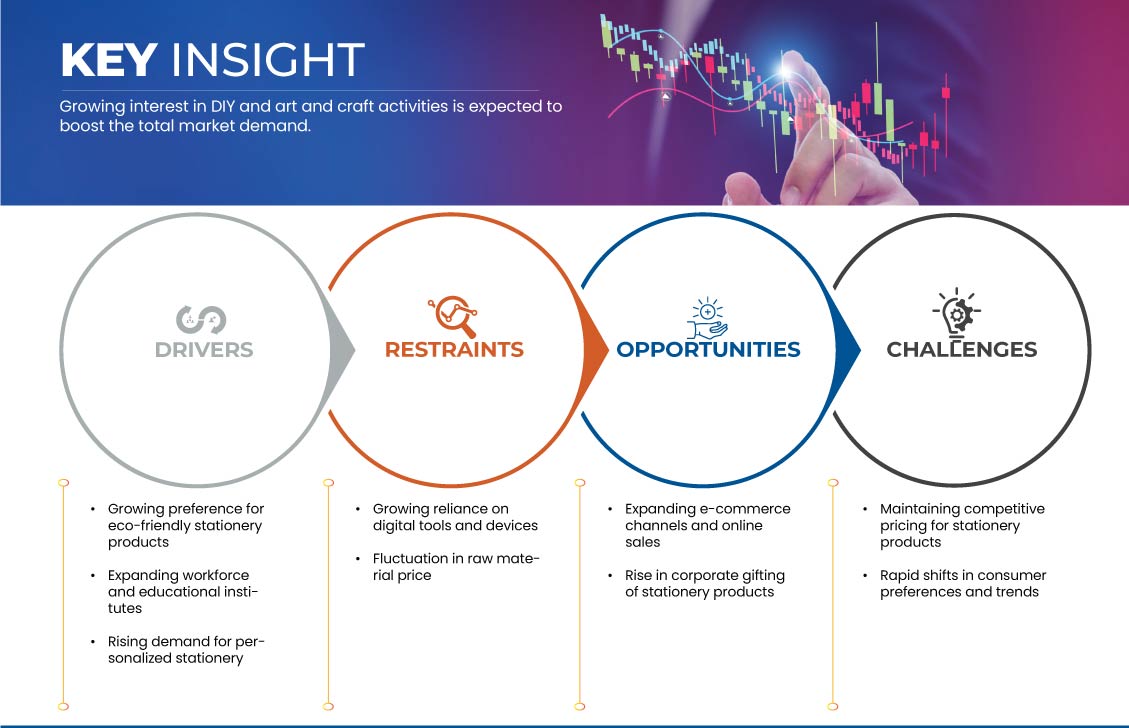Us Stationery Products Market
Market Size in USD Billion
CAGR :
% 
| 2024 –2031 | |
| USD 33,864.13 Million | |
| USD 41,914.91 Million | |
|
|
|
U.S. Stationery Products Market, By Type (Paper Products, Writing Instruments, Art & Craft, and Others), Application (Educational Institutes, Government, Corporates, and Others), Distribution Channel (Offline and Online) - Industry Trends and Forecast to 2031.
U.S. Stationery Products Market Analysis and Size
Growing preference for eco-friendly stationery products and expanding workforce and educational institutes are the major factors driving the market growth. However, the major factors restraining the market growth are growing reliance on digital tools and devices and fluctuation in raw material price. On the other hand, the rise in corporate gifting of stationery products is expected to create an opportunity for market growth. However, maintaining competitive pricing for stationery products and rapid shifts in consumer preferences and trends are expected to challenge market growth.
Data Bridge Market Research analyzes that the market is growing with a CAGR of 2.8% in the forecast period of 2024 to 2031 and is expected to reach USD 41,914.91 million by 2031 from USD 33,864.13 million in 2023.
|
Report Metric |
Details |
|
Forecast Period |
2024 to 2031 |
|
Base Year |
2023 |
|
Historic Years |
2022 (Customizable to 2016-2021) |
|
Quantitative Units |
Revenue in USD Million |
|
Segments Covered |
Type (Paper Products, Writing Instruments, Art & Craft, and Others), Application (Educational Institutes, Government, Corporates, and Others), Distribution Channel (Offline and Online) |
|
Country Covered |
U.S. |
|
Market Players Covered |
HALLMARK LICENSING, LLC, AGC, LLC., Design Group Americas, Pentel of America, Ltd., Crane Stationery, Faber-Castell, HPG, Linc Limited, Papier , and RIFLE, INC., among others |
Market Definition
Stationery products encompass a diverse array of essential items used for writing, organization, and creative expression. This category includes writing instruments such as pens, pencils, and markers, and paper products such as notebooks, notepads, envelopes, and organizational tools such as folders and binders.
U.S. Stationery Products Market Dynamics
This section deals with understanding the market drivers, opportunities, challenges, and restraints. All of this is discussed in detail below:
Drivers
- Growing Preference for Eco-Friendly Stationery Products
Increased environmental awareness has led to a shift in consumer preferences towards sustainable and eco-friendly options. As consumers become more conscious of their ecological impact, there is a growing demand for stationery products that align with environmentally friendly practices. Increased awareness of environmental issues, such as deforestation, pollution, and climate change, has prompted consumers to seek products that have a lower impact on the planet. Eco-friendly stationery is perceived as a more sustainable and responsible choice. Eco-friendly stationery options are often produced using environmentally friendly manufacturing processes that aim to minimize carbon emissions. Consumers who are concerned about their carbon footprint are drawn to products with a lower environmental impact. Traditional stationery products can contribute to waste, especially if they are not easily recyclable. Eco-friendly stationery options, such as those made from recycled or biodegradable materials, align with the goal of reducing overall waste generation.
The demand for eco-friendly stationery stimulates innovation in product development. Manufacturers explore new materials, production processes, and designs to create sustainable alternatives, fostering creativity within the industry. Eco-friendly stationery products often come with labels and certifications, such as the Forest Stewardship Council (FSC) certification or eco-friendly logos. These indicators provide consumers with tangible evidence of a product's commitment to sustainability.
- Rising Demand for Personalized Stationery
The growing demand for personalized stationery is fueled by a combination of individual expression, corporate branding strategies, and the ease of customization in the digital age. Personalization allows consumers to express their individuality and unique style through their stationary items. Whether its custom-designed notebooks, personalized pens, or monogrammed planners, consumers appreciate the ability to make these everyday items uniquely their own.
The demand for personalized stationery surges during special occasions and events. Consumers seek customized items for gifts during birthdays, weddings, graduations, and other celebrations, driving a significant portion of the market during peak gifting seasons. The demand for personalized stationery surges during special occasions and events. Consumers seek customized items for gifts during birthdays, weddings, graduations, and other celebrations, driving a significant portion of the market during peak gifting seasons.
Companies are increasingly investing in personalized stationery for their employees. Customized office supplies, including notebooks, pens, and desk accessories, contribute to a unique and cohesive corporate identity while fostering a sense of pride among employees. Personalized stationery is often perceived as having higher intrinsic value due to the thoughtful customization. Consumers are willing to invest more in personalized items, enhancing the perceived quality of the product and contributing to overall market revenue.
Opportunity
- Rise in Corporate Gifting of Stationery Products
Corporations are increasingly recognizing the value of stationery as thoughtful and practical gifts for clients, employees, and business associates. This trend is particularly driven by the desire to offer functional and branded items that align with professionalism and utility, contributing to a positive brand image. The corporate gifting of stationery extends beyond traditional items such as pens and notebooks, encompassing a diverse range of products, including custom-designed planners, premium writing instruments, and high-quality leather-bound portfolios.
Businesses are now looking for unique and customizable stationery items that can serve as effective promotional tools while maintaining a sense of sophistication. The demand for personalized stationery aligns with the corporate world's emphasis on individualization, reflecting a company's commitment to fostering relationships and leaving a lasting impression. Manufacturers in the stationery products market have the chance to diversify their offerings and cater to the specific needs of corporate clients, as corporations seek to enhance their brand visibility through practical and aesthetically pleasing gifts, Furthermore, the rise in remote work arrangements, accelerated by global events, has contributed to the popularity of stationery products in corporate gifting. The significance of sending tangible and practical gifts has grown, as companies navigate the challenges of maintaining a connected and motivated workforce in dispersed settings. Stationery items, such as personalized notebooks or quality pens, serve as tangible reminders of corporate culture and appreciation. This trend has expanded the potential market for stationery products beyond traditional office settings, reaching employees working from home or in hybrid work environments.
Challenges/ Restraints
- Fluctuation in Raw Material Prices
The stationery product manufacturing process relies on raw materials such as paper, ink, plastic, and metal. Fluctuations in the prices of these materials directly affect production costs. When raw material prices increase, manufacturers may face higher expenses, potentially squeezing profit margins unless they adjust product pricing.
Paper is a fundamental component of stationery products, and its price can be subject to fluctuations based on factors such as pulp prices, demand, and supply chain disruptions. Similarly, printing materials such as inks and toners may experience price volatility, impacting the overall cost of production
Fluctuating raw material prices can lead to supply chain disruptions, affecting the timely availability of materials for production. Sudden spikes in prices may strain the supply chain, causing delays in manufacturing and potentially leading to inventory challenges for stationery product manufacturers. The stationery product market often caters to price-sensitive consumers. When raw material prices rise, manufacturers may face the dilemma of whether to pass on the increased costs to consumers through higher prices. This decision can impact consumer demand, as higher prices may lead to reduced purchasing.
Smaller enterprises within the stationery product market, operating with limited resources, may be disproportionately affected by volatile raw material prices. Their capacity to negotiate favorable contracts or absorb sudden cost increases is limited, posing a threat to their viability
- Growing Reliance on Digital Tools and Devices
The increased use of digital devices for communication and note-taking can lead to a reduced demand for traditional writing tools such as pens, pencils, and markers. Digital note-taking applications and devices may replace the need for physical writing instruments. The prevalence of digital communication methods, including emails, instant messaging, and social media, may diminish the demand for physical greeting cards and stationery. Digital alternatives are often considered more convenient and immediate.
The digitalization of office workflows has led to a decrease in the use of physical stationery items in professional settings. Digital documentation, e-signatures, and collaborative online platforms are replacing traditional paper-based office supplies. The move towards paperless initiatives in various sectors, including businesses and educational institutions, may result in a decreased demand for paper products such as notebooks, notepads, and sticky notes.
The popularity of digital planners, calendars, and task management apps can reduce the reliance on traditional paper-based planners and organizers. Many individuals now prefer the convenience and accessibility of digital planning tools. The rise of e-books and digital reading platforms has impacted the traditional print industry, including the demand for physical books and related stationery products. Consumers increasingly opt for digital reading materials. The integration of digital features into everyday items, such as smart notebooks or digital writing tablets, can alter consumer preferences. These technological advancements may influence users to opt for multifunctional digital tools over traditional stationery.
Recent Development
- In November 2023, REEDS Jewelers launched an exclusive new jewelry collection, Papyrus in partnership with American Greetings Corporation, which is a premium brand in the Celebrations marketplace. This will enhance the company’s brand image
U.S. Stationery Products Market Scope
The U.S. stationery products market is categorized based on type, application, and distribution channel. The growth amongst these segments will help you analyze major growth segments in the industries and provide the users with a valuable market overview and market insights to make strategic decisions to identify core market applications.
Type
- Paper Products
- Writing Instruments
- Art & Craft
- Others
On the basis of type, the U.S. stationery products market is segmented into paper products, writing instruments, art & craft, and others.
Application
- Educational Institutes
- Government
- Corporates
- Others
On the basis of application, the U.S. stationery products market is segmented into educational institutes, government, corporates, and others.
Distribution Channel
- Offline
- Online
On the basis of distribution channel, the U.S. stationery products market is segmented into offline and online.
U.S. Stationery Products Market Competitive Landscape and Share Analysis
The U.S. stationery products market competitive landscape provides details by competitors. Details included are company overview, company financials, revenue generated, market potential, investment in research and development, new market initiatives, production sites and facilities, company strengths and weaknesses, product launch, product trials pipelines, product approvals, patents, product width and breadth, application dominance, technology lifeline curve. The above data points provided are only related to the companies’ focus related to the market.
Some of the major market players operating in U.S. stationery products market are RIFLE, INC., Faber-Castell, Crane Stationery, Pentel of America, Ltd., HALLMARK LICENSING, LLC, HPG, American Greetings Corporation, Design Group Americas, Papier, and Linc Limited, among others.
SKU-
Get online access to the report on the World's First Market Intelligence Cloud
- Interactive Data Analysis Dashboard
- Company Analysis Dashboard for high growth potential opportunities
- Research Analyst Access for customization & queries
- Competitor Analysis with Interactive dashboard
- Latest News, Updates & Trend analysis
- Harness the Power of Benchmark Analysis for Comprehensive Competitor Tracking
Table of Content
1 INTRODUCTION
1.1 OBJECTIVES OF THE STUDY
1.2 MARKET DEFINITION
1.3 OVERVIEW OF THE U.S. STATIONERY PRODUCTS MARKET
1.4 LIMITATIONS
1.5 MARKETS COVERED
2 MARKET SEGMENTATION
2.1 MARKETS COVERED
2.2 GEOGRAPHICAL SCOPE
2.3 YEARS CONSIDERED FOR THE STUDY
2.4 CURRENCY AND PRICING
2.5 DBMR TRIPOD DATA VALIDATION MODEL
2.6 MULTIVARIATE MODELLING
2.7 PRIMARY INTERVIEWS WITH KEY OPINION LEADERS
2.8 DBMR MARKET POSITION GRID
2.9 MARKET APPLICATION COVERAGE GRID
2.1 VENDOR SHARE ANALYSIS
2.11 SECONDARY SOURCES
2.12 ASSUMPTIONS
3 EXECUTIVE SUMMARY
4 PREMIUM INSIGHTS
4.1 APPLICATIONS AND PRICE ANALYSIS: U.S. STATIONERY PRODUCTS MARKET
4.1.1 APPLICATION AND PRICE ANALYSIS
4.1.2 HALLMARK LICENSING, LLC
4.1.3 AGC,LLC.
4.1.4 DESIGN GROUP AMERICAS
4.1.5 PENTEL OF AMERICA LTD
4.1.6 CRANE STATIONERY
5 MARKET OVERVIEW
5.1 DRIVERS
5.1.1 GROWING PREFERENCE FOR ECO-FRIENDLY STATIONERY PRODUCTS
5.1.2 RISING DEMAND FOR PERSONALIZED STATIONERY
5.1.3 GROWING INTEREST IN DIY AND ART AND CRAFT ACTIVITIES
5.1.4 EXPANDING WORKFORCE AND EDUCATIONAL INSTITUTES
5.2 RESTRAINTS
5.2.1 FLUCTUATION IN RAW MATERIAL PRICES
5.2.2 GROWING RELIANCE ON DIGITAL TOOLS AND DEVICES
5.3 OPPORTUNITIES
5.3.1 RISE IN CORPORATE GIFTING OF STATIONERY PRODUCTS
5.3.2 EXPANDING E-COMMERCE CHANNELS AND ONLINE SALES
5.4 CHALLENGES
5.4.1 MAINTAINING COMPETITIVE PRICING FOR STATIONERY PRODUCTS
5.4.2 RAPID SHIFTS IN CONSUMER PREFERENCES AND TRENDS
6 U.S. STATIONERY PRODUCTS MARKET, BY TYPE
6.1 OVERVIEW
6.2 PAPER PRODUCTS
6.3 WRITING INSTRUMENTS
6.4 ART & CRAFT
6.5 OTHERS
7 U.S. STATIONERY PRODUCTS MARKET, BY APPLICATION
7.1 OVERVIEW
7.2 EDUCATIONAL INSTITUTES
7.3 GOVERNMENT
7.4 CORPORATES
7.5 OTHERS
8 U.S. STATIONERY PRODUCTS MARKET, BY DISTRIBUTION CHANNEL
8.1 OVERVIEW
8.2 OFFLINE
8.2.1 SUPERMARKETS/HYPERMARKETS
8.2.2 CONVENIENCE STORES
8.2.3 SPECIALTY STORES
8.2.4 OTHERS
8.3 ONLINE
8.3.1 COMPANY OWNED WEBSITES
8.3.2 E-COMMERCE/THIRD PARTY WEBSITES
9 U.S. STATIONERY PRODUCTS MARKET, COMPANY LANDSCAPE
9.1 COMPANY SHARE ANALYSIS: U.S.
10 SWOT ANALYSIS
11 COMPANY PROFILES
11.1 HALLMARK LICENSING, LLC
11.1.1 COMPANY SNAPSHOT
11.1.2 PRODUCT PORTFOLIO
11.1.3 RECENT DEVELOPMENT
11.2 AGC,LLC.
11.2.1 COMPANY SNAPSHOT
11.2.2 PRODUCT PORTFOLIO
11.2.3 RECENT DEVELOPMENT
11.3 DESIGN GROUP AMERICAS
11.3.1 COMPANY SNAPSHOT
11.3.2 PRODUCT PORTFOLIO
11.3.3 RECENT DEVELOPMENTS
11.4 PENTEL OF AMERICA, LTD.
11.4.1 COMPANY SNAPSHOT
11.4.2 PRODUCT PORTFOLIO
11.4.3 RECENT DEVELOPMENTS
11.5 CRANE STATIONERY
11.5.1 COMPANY SNAPSHOT
11.5.2 PRODUCT PORTFOLIO
11.5.3 RECENT DEVELOPMENTS
11.6 FABER-CASTELL
11.6.1 COMPANY SNAPSHOT
11.6.2 PRODUCT PORTFOLIO
11.6.3 RECENT DEVELOPMENTS
11.7 HPG
11.7.1 COMPANY SNAPSHOT
11.7.2 PRODUCT PORTFOLIO
11.7.3 RECENT DEVELOPMENTS
11.8 LINC LIMITED
11.8.1 COMPANY SNAPSHOT
11.8.2 REVENUE ANALYSIS
11.8.3 PRODUCT PORTFOLIO
11.8.4 RECENT DEVELOPMENTS
11.9 PAPIER
11.9.1 COMPANY SNAPSHOT
11.9.2 PRODUCT PORTFOLIO
11.9.3 RECENT DEVELOPMENTS
11.1 RIFLE, INC.
11.10.1 COMPANY SNAPSHOT
11.10.2 PRODUCT PORTFOLIO
11.10.3 RECENT DEVELOPMENTS
12 QUESTIONNAIRE
13 RELATED REPORTS
List of Figure
FIGURE 1 U.S. STATIONERY PRODUCTS MARKET: SEGMENTATION
FIGURE 2 U.S. STATIONERY PRODUCTS MARKET: DATA TRIANGULATION
FIGURE 3 U.S. STATIONERY PRODUCTS MARKET: DROC ANALYSIS
FIGURE 4 U.S. STATIONERY PRODUCTS MARKET: COUNTRY VS REGIONAL ANALYSIS
FIGURE 5 U.S. STATIONERY PRODUCTS MARKET: COMPANY RESEARCH ANALYSIS
FIGURE 6 U.S. STATIONERY PRODUCTS MARKET: INTERVIEW DEMOGRAPHICS
FIGURE 7 U.S. STATIONERY PRODUCTS MARKET: DBMR MARKET POSITION GRID
FIGURE 8 U.S. STATIONERY PRODUCTS MARKET: MARKET APPLICATION COVERAGE GRID
FIGURE 9 U.S. STATIONERY PRODUCTS MARKET: VENDOR SHARE ANALYSIS
FIGURE 10 U.S. STATIONERY PRODUCTS MARKET: SEGMENTATION
FIGURE 11 GROWING INTEREST IN DIY AND ART & CRAFT ACTIVITIES IS DRIVING THE GROWTH OF THE U.S. STATIONERY PRODUCTS MARKET IN THE FORECAST PERIOD OF 2024 TO 2031
FIGURE 12 THE PAPER PRODUCTS SEGMENT IS EXPECTED TO ACCOUNT FOR THE LARGEST SHARE OF THE U.S. STATIONERY PRODUCTS MARKET IN 2024 AND 2031
FIGURE 13 DRIVERS, RESTRAINTS, OPPORTUNITIES, AND CHALLENGES OF U.S. STATIONERY PRODUCTS MARKET
FIGURE 14 U.S. RETAIL SALES VIA E-COMMERCE IN 2022 (USD MILLION)
FIGURE 15 REVENUE EARNED BY COURIERS AND EXPRESS DELIVERY SERVICE IN THE U.S. (2018-2021) (USD MILLION)
FIGURE 16 U.S. STATIONERY PRODUCTS MARKET: BY TYPE, 2023
FIGURE 17 U.S. STATIONERY PRODUCTS MARKET: BY APPLICATION, 2023
FIGURE 18 U.S. STATIONERY PRODUCTS MARKET: BY DISTRIBUTION CHANNEL, 2023
FIGURE 19 U.S. STATIONERY PRODUCTS MARKET: COMPANY SHARE 2023 (%)
Research Methodology
Data collection and base year analysis are done using data collection modules with large sample sizes. The stage includes obtaining market information or related data through various sources and strategies. It includes examining and planning all the data acquired from the past in advance. It likewise envelops the examination of information inconsistencies seen across different information sources. The market data is analysed and estimated using market statistical and coherent models. Also, market share analysis and key trend analysis are the major success factors in the market report. To know more, please request an analyst call or drop down your inquiry.
The key research methodology used by DBMR research team is data triangulation which involves data mining, analysis of the impact of data variables on the market and primary (industry expert) validation. Data models include Vendor Positioning Grid, Market Time Line Analysis, Market Overview and Guide, Company Positioning Grid, Patent Analysis, Pricing Analysis, Company Market Share Analysis, Standards of Measurement, Global versus Regional and Vendor Share Analysis. To know more about the research methodology, drop in an inquiry to speak to our industry experts.
Customization Available
Data Bridge Market Research is a leader in advanced formative research. We take pride in servicing our existing and new customers with data and analysis that match and suits their goal. The report can be customized to include price trend analysis of target brands understanding the market for additional countries (ask for the list of countries), clinical trial results data, literature review, refurbished market and product base analysis. Market analysis of target competitors can be analyzed from technology-based analysis to market portfolio strategies. We can add as many competitors that you require data about in the format and data style you are looking for. Our team of analysts can also provide you data in crude raw excel files pivot tables (Fact book) or can assist you in creating presentations from the data sets available in the report.






